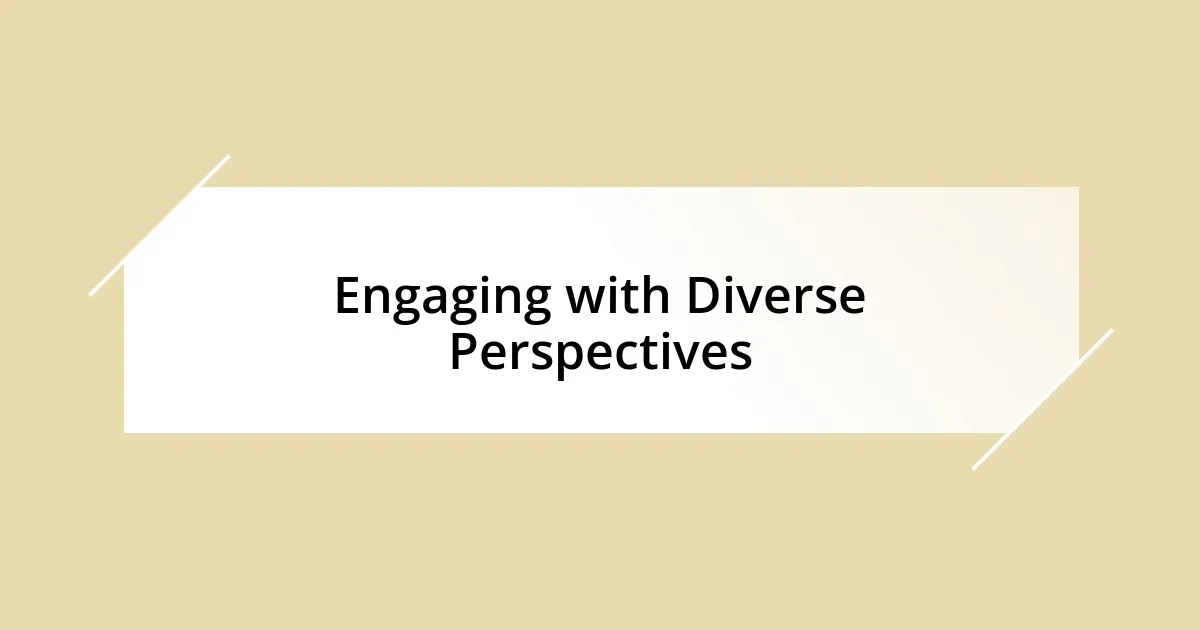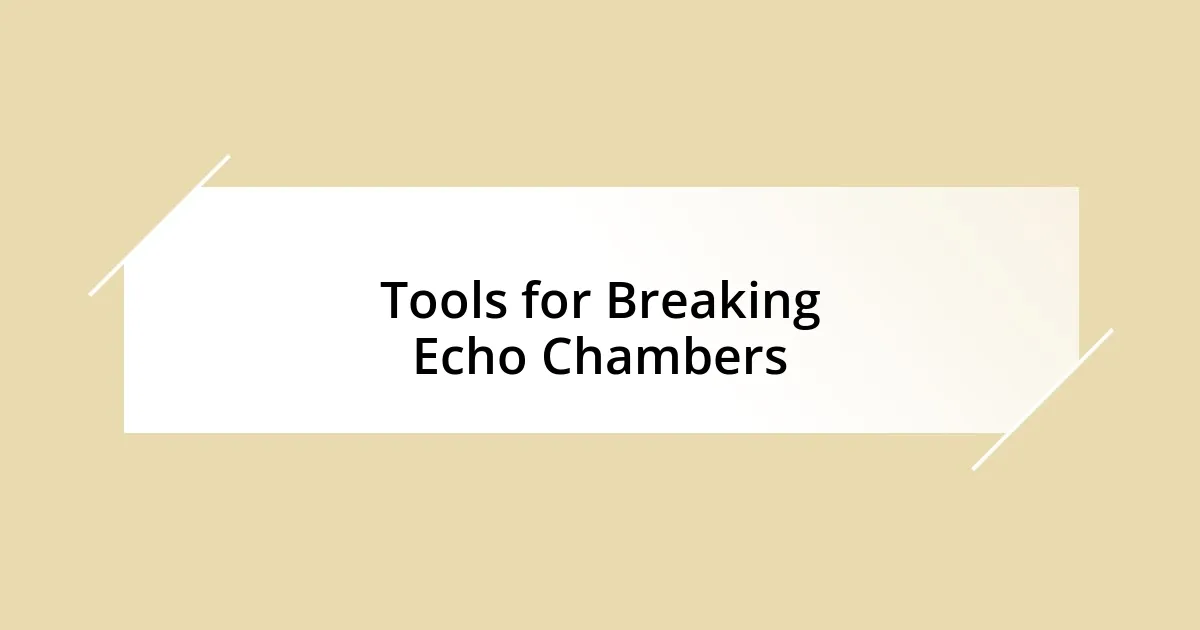Key takeaways:
- Echo chambers foster a narrow worldview by surrounding individuals with similar ideas, limiting critical thought and diverse perspectives.
- Identifying one’s echo chamber involves reflecting on social interactions, news consumption, and engagement with opposing views.
- Engaging with diverse perspectives enhances understanding, develops empathy, and promotes critical thinking and conflict resolution.
- Building connections across divides requires vulnerability, active listening, and an openness to different narratives to foster mutual understanding.

Understanding Echo Chambers
Echo chambers are fascinating yet concerning environments where individuals are exposed primarily to ideas and opinions that mirror their own. I can remember a time when I found myself engrossed in a social media group that only reaffirmed my views on a controversial topic. At first glance, it felt like a supportive space, but over time, I realized it limited my perspective and shaped my beliefs in an echoing, rather than enlightening, way.
What’s intriguing is how these chambers can quietly transform our understanding of reality. Have you ever noticed how conversations with friends can morph into a series of affirmations instead of healthy debates? That’s the echo chamber effect at work. It creates a false sense of consensus that can lead us to believe that our viewpoint is universally accepted, leaving little room for critical thought or differing opinions.
Emotionally, I felt a disconnection when I finally stepped back and surveyed the broader discourse outside my bubble. It was jarring to realize how insulated I had become. The challenge is to break free and actively seek out diverse perspectives, which can enrich our understanding rather than just reinforce our beliefs. Isn’t it essential to embrace a world where we can challenge our views and grow from the exchange of ideas?

Identifying Your Own Echo Chamber
Recognizing your own echo chamber can be an eye-opening experience. I once thought I was well-informed until I realized the news sources I relied on were all saying the same thing, fostering a one-dimensional view of current events. That moment of clarity hit me hard. It was like pulling back a curtain to expose a whole new landscape of opinions and information waiting to be discovered.
To identify your echo chamber, consider these reflective questions:
– Are the people you surround yourself with mostly sharing similar beliefs?
– Do your news feeds show a repetitive narrative or confirmation of your existing opinions?
– When was the last time you engaged with someone who held an opposing view?
– Do you feel uncomfortable discussing certain topics for fear of disagreement?
– How often do you seek out new information from diverse sources?
Each of these reflections can help you gauge the diversity (or lack thereof) in your information consumption and social interactions. The more open and curious I became, the brighter the world outside my echo chamber became.

Engaging with Diverse Perspectives
Engaging with diverse perspectives is not just about breaking free from my echo chamber; it’s a truly enriching experience. I recall a moment when I attended a community forum where individuals from different backgrounds shared their stories. Each narrative challenged my assumptions and pushed me to reconsider my views. It was enlightening to hear firsthand accounts that diverged from the headlines I so often consumed.
I’ve also found that engaging with diversity can be a bit uncomfortable at first. During one discussion with friends who held opposing views, I felt a rush of defensiveness. But as we talked, I recognized that these conversations were essential for growth. Instead of seeing the conflict as a threat, I embraced it as an opportunity to deepen my understanding and resilience. Isn’t it fascinating how disagreement can pave the way to newfound wisdom?
In connecting with varied perspectives, I’ve learned to appreciate both the similarities and the differences among us. I remember a deep conversation I had with a colleague from a vastly different background, which illuminated shared human experiences despite our differing views on specific issues. This exchange not only broadened my horizon but also humanized the topics we often debate.
| Engaging with Diverse Perspectives | Benefits |
|---|---|
| Increased Understanding | Gaining insights beyond one’s usual worldview |
| Empathy Development | Enhancing emotional intelligence and connection with others |
| Critical Thinking | Encouraging deeper analysis and reflection on personal beliefs |
| Conflict Resolution | Learning to navigate disagreement constructively |

Tools for Breaking Echo Chambers
The most effective tool I’ve discovered for breaking echo chambers is actively seeking out new voices. I remember stumbling upon a podcast featuring individuals from cultures and ideologies I knew little about. At first, I was hesitant—did I want to hear their perspectives? What if it challenged everything I believed? Instead, I surprised myself by finding common ground that not only enriched my understanding but also showed me just how much I had been missing.
Another powerful method I’ve used involves curating my social media feeds. By intentionally following people who express differing opinions, I’ve witnessed a shift in my daily news consumption. One day, a heated debate erupted in a comment section about climate change, and rather than withdrawing, I engaged with various viewpoints. This experience highlighted the complexity of the issue, reinforcing the idea that multiple narratives coexist, each with its own valid points. How often do we let algorithms dictate what we see, to our detriment?
Finally, joining discussion groups or forums can also be transformative. I participated in a local book club where diverse selections prompted rich dialogue. Initially, I felt intimidated; what if my views were too far off? But as I listened and contributed, I felt a sense of camaraderie grow—even amidst disagreement. It’s remarkable how sharing space with others who think differently can spark not only empathy but also personal growth. Have you experienced that moment when a new perspective makes you rethink your stance completely? It’s those moments that can truly reshape our worldview.

Building Bridges Across Divides
Connecting across divides requires intentionality and openness. I remember a neighborhood gathering where we discussed community issues with people whose opinions often clash. Initially, the atmosphere was tense, but as stories flowed, I found myself laughing with someone whose views I once dismissed. It’s remarkable how shared experiences—like parenting struggles or local frustrations—can bridge gaps that seemed insurmountable.
Throughout my journey, I’ve discovered that vulnerability plays a key role in building these bridges. During one particularly raw conversation with my family, we addressed our differing political beliefs. As I shared my fears and insecurities, the walls crumbled. It led us to a space where we could appreciate each other’s humanity. It made me ponder: What if we all approached disagreements from a place of vulnerability? How might that shift our conversations?
Active listening is another powerful tool I’ve leaned on when connecting with those across divides. I recall a workshop I attended on conflict resolution, and the facilitator emphasized the impact of simply hearing someone out. One participant shared a deeply personal narrative about their struggles, and I realized how often I jump to respond instead of absorbing their words. That experience wasn’t just illuminating; it taught me that sometimes, being present is the best way to build understanding. Have you ever noticed how a well-timed silence can speak volumes?














